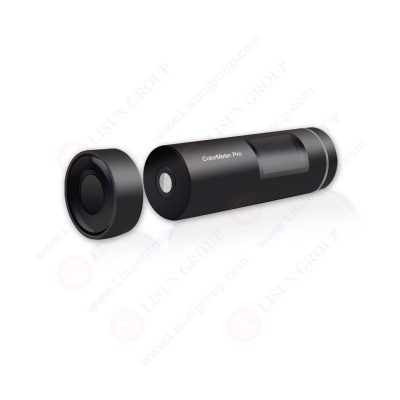
In the development of optical instruments, physical optics is the most fundamental theoretical basis, and both the internal results of Colorimeter and gloss meter involve physical optics. Involving physical optics can enhance customers' understanding of the instrument and help customers who have purchased color difference meters and gloss meters better use the instrument and analyze data.
Corpuscular theory (Newton)
In this theory, light is thought to be like a group of small elastic particles.
Fluctuation Theory (Huygens)
It is believed that light is a wave (mechanical wave) excited by some kind of vibration.
① The Interference Phenomenon of "A" -- Young's Double Slit Interference Experiment
The two beams of light have the same frequency and constant phase difference. The phenomenon appears as a central bright strip with evenly spaced alternating light and dark stripes on both sides. Explain that when the distance difference from a certain point on the screen to a double hole (double slit) is an integer multiple of the wavelength (even multiple of a half wavelength), the two waves are superposed in phase, resulting in enhanced vibration and the generation of a bright strip; The two waves are superposed inversely, and the vibrations cancel, creating a filament. Apply inspection planes, measure thickness, and enhance the transmitted light intensity of optical lenses (antireflective films)
② The diffraction phenomenon of light - single slit diffraction (or circular aperture diffraction)
The conditional slit width (or aperture) can be compared to the wavelength. The phenomenon appears as the brightest and widest bright strip in the center, and the light and dark stripes (or rings in the countryside) published at unequal intervals on both sides. The difficult problem is that it is difficult to explain the straightness of light and the inability to find the propagation medium.
Electromagnetic Theory (Maxwell)
Think of light as an electromagnetic wave.
Generation mechanisms of various electromagnetic waves The movement of free electrons in radio waves; The outer electrons of infrared, visible, and ultraviolet atoms are excited; The electrons in the inner layer of the X-ray atom are excited; γ The nucleus of a radiation atom is excited. Spectral emission spectrum of visible light - continuous spectrum, bright line spectrum; The absorption spectrum (characteristic spectrum) is difficult to explain the photoelectric effect phenomenon.
Photon theory (Einstein)
It is believed that light consists of discrete parts of photons, and the energy of each photon is E=h ν。
Phenomenon
①. The incident light is almost instantaneous to the photoelectron emission;
②. The incident light frequency must be greater than the limit frequency of the photocathode metal ν;
③. When ν> v。 The intensity of photocurrent is proportional to the intensity of incident light;
④. The maximum initial kinetic energy of the photoelectron is independent of the incident light intensity and only increases with the increase in the human beam lamp.
Interpretation
①. Photon energy can be fully absorbed by electrons without the need for an energy accumulation process;
②. The surface electrons need to do at least work (escape work) h to escape against the gravitational force of the metal atomic nucleus ν;
③. Incident light intensity. More incident photons per unit time produce more photoelectrons;
④. The energy of an incident photon is only related to its frequency, and it is incident onto a metal surface, except for the purpose of escaping work. The rest is converted into the initial kinetic energy of photoelectrons. Difficult questions cannot explain the volatility of light.
Wave-particle duality of light
It is believed that light is a substance with electromagnetic nature, which has both wave characteristics.
It also has particle properties. The motion law of a large number of photons shows volatility, and the behavior of individual photons shows particle property. Experimental basis: interference of weak light, X-ray diffraction
These physical optics have applications in real life, where the theories of physical optics are embodied in color difference meters and glossmeters. The application of these theories directly determines the instrument's optical path, internal results, and data calculation methods.
Portable Colorimeter/Chroma Meter is an innovation color measuring tool with powerful configuration to make color measurement easier and more professional; It support Bluetooth to connect with Android and ISO devices, Portable Colorimeter/Chroma Meter will take you into a new world of color management; It can be widely used to measure color value, color difference value and find similar color from color cards for printing industry, paint industry, textile industry, etc.
Gloss meters AGM-580 are mainly used in the surface gloss measurement for paint, plastic, metal, ceramics, building materials. It conforms to the DIN67530, ISO2813, ASTM D523, JIS Z8741, BS 3900 Part D5, JJG696 standards and so on.
Lisun Instruments Limited was found by LISUN GROUP in 2003. LISUN quality system has been strictly certified by ISO9001:2015. As a CIE Membership, LISUN products are designed based on CIE, IEC and other international or national standards. All products passed CE certificate and authenticated by the third party lab.
Our main products are Goniophotometer, Integrating Sphere, Spectroradiometer, Surge Generator, ESD Simulator Guns, EMI Receiver, EMC Test Equipment, Electrical Safety Tester, Environmental Chamber, Temperature Chamber, Climate Chamber, Thermal Chamber, Salt Spray Test, Dust Test Chamber, Waterproof Test, RoHS Test (EDXRF), Glow Wire Test and Needle Flame Test.
Please feel free to contact us if you need any support.
Tech Dep: Service@Lisungroup.com, Cell/WhatsApp:+8615317907381
Sales Dep: Sales@Lisungroup.com, Cell/WhatsApp:+8618117273997
https://www.lisungroup.com/news/technology-news/physical-optics-gloss-meter-and-colorimeter.html


Comments
Post a Comment